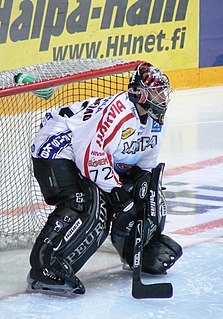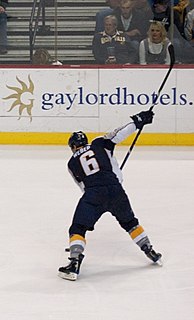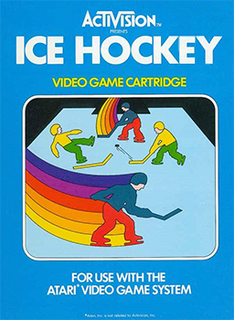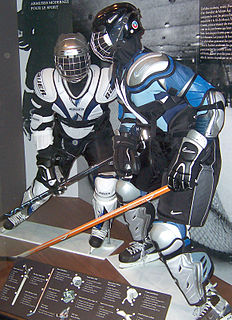"Backhand shot" redirects here. For the tennis shot, see
Backhand.
In ice hockey, a backhanded shot (or backhander) is a shot taken from the backside of the blade. This type of shot is often used on breakaways, penalty shots and in shootouts and is used for deking. Compared to a forehand shot, it is less accurate, less powerful, but more deceptive to goaltenders. It is also used when a player can not pass the puck to someone who is facing the outside bend of the stick.

Ice hockey is a contact team sport played on ice, usually in a rink, in which two teams of skaters use their sticks to shoot a vulcanized rubber puck into their opponent's net to score points. The sport is known to be fast-paced and physical, with teams usually consisting of six players each: one goaltender, and five players who skate up and down the ice trying to take the puck and score a goal against the opposing team.
A shot in ice hockey is an attempt by a player to score a goal by striking or snapping the puck with their stick in the direction of the net.
A hockey stick is a piece of sport equipment used by the players in all the forms of hockey to move the ball or puck either to push, pull, hit, strike, flick, steer, launch or stop the ball/puck during play with the objective being to move the ball/puck around the playing area using the stick.
The setup of this shot begins with the puck on the backhand heel side of the hockey stick. The puck location at this point will be even with or on the outside of the skate opposite of the intended direction of the shot. There will be a weight transfer from one skate to the other, also in the shot direction, when shot commences. At this time the puck will slide along the blade from the heel towards the toe with the eventual release of the puck toward the net. With a backhand shot it is much easier to release the puck from the middle of the blade, rather than the toe, because when shooting backhand the curve is in the opposite direction. The shooter does have some control over the direction of the backhand shot — by pointing the stick blade during the follow through, the player can direct the action of the puck. This shot can obviously be used with a straight stick, but can have different shot results.

Ice skates are metal blades attached underfoot and used to propel the bearer across a sheet of ice while ice skating.

In ice hockey, a goal is scored when the puck entirely crosses the goal line between the two goal posts and below the goal crossbar. A goal awards one point to the team attacking the goal scored upon, regardless of which team the player who actually deflected the puck into the goal belongs to. Typically, a player on the team attempting to score shoots the puck with their stick towards the goal net opening, and a player on the opposing team called a goaltender tries to block the shot to prevent a goal from being scored against their team.

In ice hockey, the goaltender or goalie or goalkeeper is the player responsible for preventing the hockey puck from entering their team's net, thus preventing the opposing team from scoring. The goaltender usually plays in or near the area in front of the net called the goal crease. Goaltenders tend to stay at or beyond the top of the crease to cut down on the angle of shots. In today's age of goaltending there are two common styles, butterfly and hybrid. Because of the power of shots, the goaltender wears special equipment designed to protect the body from direct impact. The goalie is one of the most valuable players on the ice, as their performance can greatly change the outcome or score of the game. One-on-one situations, such as breakaways and shootouts, have the tendency to highlight a goaltender's pure skill, or lack thereof. No more than one goaltender is allowed to be on the ice for each team at any given time. Teams are not required to use a goaltender and may instead opt to play with an additional skater, but the defensive disadvantage this poses generally means that the strategy is only used as a desperation maneuver when trailing late in a game or can be used if the opposing team has a delayed penalty.
In ice hockey, a penalty shot is a type of penalty awarded when a team loses a clear scoring opportunity on a breakaway because of a foul committed by an opposing player. A player from the non-offending team is given an attempt to score a goal without opposition from any defending players except the goaltender. This is the same type of shot used in a shootout to decide games in some leagues.

A slapshot in ice hockey is the hardest shot one can perform. It has four stages which are executed in one fluid motion to make the puck fly into the net:
- The player winds up his hockey stick to shoulder height or higher.
- Next the player violently "slaps" the ice slightly behind the puck and uses his weight to bend the stick, storing energy in it like a spring. This bending of the stick gives the slapshot its speed. Just like a bow and arrow, the stick's tendency to return to being straight is transferred to the puck, giving it much more speed than just hitting it alone could.
- When the face of the stick blade strikes the puck, the player rolls his wrists and shifts his weight so that the energy stored in the stick is released through the puck.
- Finally, the player follows through, ending up with the stick pointed towards the desired target.

A deke feint or fake is an ice hockey technique whereby a player draws an opposing player out of position or is used to skate by an opponent while maintaining possession and control of the puck. The term is a Canadianism formed by abbreviating the word decoy.

Roller in-line hockey, or inline hockey is a variant of hockey played on a hard, smooth surface, with players using inline skates to move and hockey sticks to shoot a hard, plastic puck into their opponent's goal to score points. There are five players including the goalkeeper from each team on the rink at a time, while teams normally consist of 16 players.

In ice hockey, the goaltender wears specialized goaltending equipment to protect himself from the impact of the puck and to assist himself in making saves.
A wrist shot is a type of hockey shot that involves using arm muscles to propel a puck forward from the concave side of the blade of a hockey stick. Generally, when the puck is shot in a similar manner using the convex side of the blade, it is referred to as a backhand shot. The power of a wrist shot comes from lower body strength more than arm strength. The advantage of a wrist shot over a slap shot is the minimal amount of setup required, creating an element of surprise. Moreover, a wrist shot is far more accurate than a slap shot. Conversely, the reliance on wrist and forearm muscles to propel the puck causes the wrist shot to be less powerful than the slap shot, though this is not true for all players, even those with "big shots". Transfer of bodyweight and the flex of a hockey stick are also key factors for a wrist shot. Weight should shift from the back leg to the front leg for maximum power. The flex of a stick is also key for a powerful wrist shot. Applying energy and weight onto your stick gives a whip like motion and thus provides your shot with even more power. The lower the flex number on a hockey stick, the more bend the stick creates.

Ice Hockey is an ice hockey video game designed by Alan Miller for the Atari VCS, and published by Activision in 1981. Late actor and comedian Phil Hartman starred in the commercial for the game.
A backhand slapshot is a type of shot used in the sport of ice hockey. Despite the similar name and execution, the result of the shot bears little resemblance to the traditional slapshot due to the awkwardness of the motion involved.

The "five-hole" is a nickname for the space between a goaltender's legs in ice hockey attributed to David Neal in 1980. If a player scores by shooting the puck into the goal between the goaltender's legs, he is said to have scored "through the five-hole," or to have "gone five-hole." The nickname can also be used in basketball, when a player throws a bounce pass that goes through a defender's legs. This expression comes from Canadian five pin bowling.

An ice hockey stick is a piece of equipment used in ice hockey to shoot, pass, and carry the puck across the ice. Ice hockey sticks are approximately 150–200 cm long, composed of a long, slender shaft with a flat extension at one end called the blade. The blade is the part of the stick used to contact the puck, and is typically 25 to 40 cm long. Stick dimensions can vary widely, as they are usually built to suit a particular player's size and preference. The blade is positioned at roughly a 135° angle from the axis of the shaft, giving the stick a partly 'L-shaped' appearance. The shaft of the stick is fairly rigid, but it has some flexibility to benefit some shots.
This is a list of common terms used in ice hockey along with the definition of these terms.

In ice hockey, players use specialized equipment both to facilitate the play of the game and for protection as this is a sport where injuries are common, therefore, all players are encouraged to protect their bodies from bruises and severe fractures.

There are two kinds of hockey tape used by ice hockey, field hockey, roller hockey, and lacrosse players: stick tape and shin tape.
In ice hockey, a pass is the movement of the puck from one player to another, usually by a motion of the stick. A pass differs from a shot, in that a pass is typically weaker than a shot and is not directed at the opponent's net with the intention of scoring a goal. The function of passing in ice hockey during gameplay strongly resembles the role of passing in other goal sports such as soccer and lacrosse. Passing is one of the most fundamental skills in hockey. An effective pass is described as being "stick to stick" or "tape to tape", referring to the tape on the blade of a hockey stick. Effective passing requires good vision, anticipation, and timing. A player that is an effective passer will normally record many assists, which are awarded to the second and third to last player to touch the puck before a goal. The National Hockey League record for most career assists is 1,963 by Wayne Gretzky, who is considered one of the best passers of all time. Different types of passes are employed in different situations or using different techniques:












